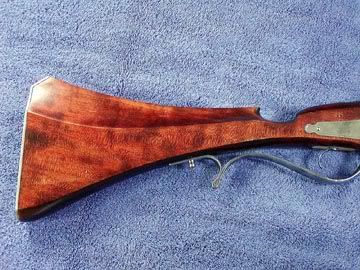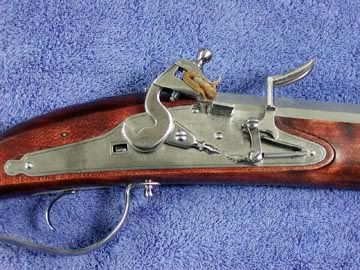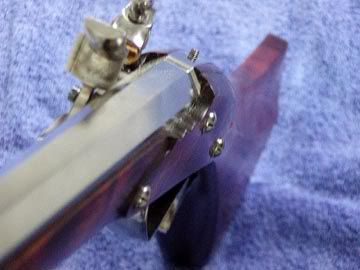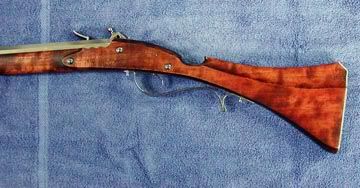-
This community needs YOUR help today. We rely 100% on Supporting Memberships to fund our efforts. With the ever increasing fees of everything, we need help. We need more Supporting Members, today. Please invest back into this community. I will ship a few decals too in addition to all the account perks you get.

Sign up here: https://www.muzzleloadingforum.com/account/upgrades -
Friends, our 2nd Amendment rights are always under attack and the NRA has been a constant for decades in helping fight that fight.
We have partnered with the NRA to offer you a discount on membership and Muzzleloading Forum gets a small percentage too of each membership, so you are supporting both the NRA and us.
Use this link to sign up please; https://membership.nra.org/recruiters/join/XR045103
You are using an out of date browser. It may not display this or other websites correctly.
You should upgrade or use an alternative browser.
You should upgrade or use an alternative browser.
Pilgrims??
- Thread starter misher
- Start date

Help Support Muzzleloading Forum:
This site may earn a commission from merchant affiliate
links, including eBay, Amazon, and others.
Russ T Frizzen
70 Cal.
- Joined
- Nov 9, 2004
- Messages
- 5,009
- Reaction score
- 417
They had matchlocks and some early style English locks. The English locks used flint but weren't quite true flint locks. MAYBE a wheel lock. Probably some Dutch guns, since they'd spent time there. Big bores and longish barrels. No blunderbuses. No funny pointed hats either.
- Joined
- Jul 31, 2006
- Messages
- 3,887
- Reaction score
- 953
Don't know about the Pilgrims but at Jamestown, locks and lock parts for snaphaunces, english and dog locks and wheelocks have all been found. While matchlocks were very common in the 1st qtr of the 17th century, an inventory from 1625 shows only 47 of 1089 firearms in the Virginia Colony were matchlocks. The French are credited with development of the (modern?) flintlock early in the 17th century and according to the Jamestown site, these locks can be documented to at least the 1660s. Hope this gives a general idea of what was around at the time.
"Let your piece be long in barrel and fear not the weight of it for most of our shooting is from stands..." -Pilgrim letter from 1621 quoted on page 738 of the latest Flaydermans
In this context long in barrel would be over 48" and up to 60" or more
In this context long in barrel would be over 48" and up to 60" or more
so, what caliber would they be?
some data from Peter Engerisser's website
Key
1)Manufacturing location
2)Barrel caliber (balls to the pound)
3)Barrel caliber (mm corrected for regional measures)
4)Bullet caliber (balls to the pound)
5)Bullet caliber (mm corrected for regional measures)
6)Dating
Muskets:
Holland
8 balls
21.6 mm
10 balls
20.0 mm
until ca.1615
Suhl / Amsterdam
10 balls
19.7 mm
12 balls
18.5 mm
from ca.1630
Augsburg
13 balls
18.8 mm
15 balls
17.9 mm
Nürnberg
14 balls
18.3 mm
16 balls
17.5 mm
in 1631
Nürnberg
16 balls
17.5 mm
18 balls
16.8 mm
in 1634
Amsterdam
15 balls
17.7 mm
17 balls
17.0 mm
1620-1630
Key
1)Manufacturing location
2)Barrel caliber (balls to the pound)
3)Barrel caliber (mm corrected for regional measures)
4)Bullet caliber (balls to the pound)
5)Bullet caliber (mm corrected for regional measures)
6)Dating
Muskets:
Holland
8 balls
21.6 mm
10 balls
20.0 mm
until ca.1615
Suhl / Amsterdam
10 balls
19.7 mm
12 balls
18.5 mm
from ca.1630
Augsburg
13 balls
18.8 mm
15 balls
17.9 mm
Nürnberg
14 balls
18.3 mm
16 balls
17.5 mm
in 1631
Nürnberg
16 balls
17.5 mm
18 balls
16.8 mm
in 1634
Amsterdam
15 balls
17.7 mm
17 balls
17.0 mm
1620-1630
Quoting from page 227 in Azel Ames book "THE MAY-FLOWER & HER LOG" Copyright 1901
Houghton, Mifflin and Company
The Riverside Pres
1907 (Second Edition)
"The arms and accoutrements (besides ordance) of the May-Flower Pilgrims, known on authority of Bradford and Winslow to have been brought by them, included muskets ("matchlocks"), "snaphances" (flintlocks), armor ("corslets," " curiasses," "helmets," "bandoliers," etc.), swords, "curtlaxes" (cutlasses), "daggers," powder, "mould-shot," "match" (slow-match for guns), "flints," belts, "knapsacks," "drum," "trumpet," "manacles," leg-irons," etc., etc. "Pistols" (brass) appear in early inventories, but their absence in the early hand-to-hand encounter at Wesagussett indicates that none were then available, or that they were not trusted..."
This was in 1620-1621 depending on the calender type you choose to use.
On page 228, a interesting list of things that a man named Josselyn gives in a booklet he wrote in 1629 for each average person wishing to make a similar voyage was:
""Armor compleat:--
One long piece (musket) five feet or five and a half long.
One Sword. One bandoleer. One belt. Twenty pounds of powder.
Sixty pounds of shot or lead, pistol and Goose-shot..."
The amount of powder and lead would indicate they were shooting a 3:1 ratio in their hand held guns.
In todays guns that would be a powder load of about
.45 caliber = 43 grains of powder
.50 caliber = 59 grains of powder
.54 caliber = 77 grains of powder
.62 caliber = 113 grains of powder
.69 caliber = 157 grains of powder
.75 caliber = 202 grains of powder
Of course all of these numbers are based on the weight of solid lead roundballs and the powder charges for the larger caliber guns shooting shot would be different.
For instance, a 12 bore shooting a 1 ounce load of shot (437 grains) would likely load about 194 grains of powder, or a 16 bore shooting shot would be about 145 grains if the ratio of 3:1 was held to.
I also have little doubt that the powder available in 1629 was not of as high of quality as the powder we now use.
Also, some of the powder per shot went for priming the pan.
The Pilgrims also had several cannon sized guns that they mounted by their town.
Houghton, Mifflin and Company
The Riverside Pres
1907 (Second Edition)
"The arms and accoutrements (besides ordance) of the May-Flower Pilgrims, known on authority of Bradford and Winslow to have been brought by them, included muskets ("matchlocks"), "snaphances" (flintlocks), armor ("corslets," " curiasses," "helmets," "bandoliers," etc.), swords, "curtlaxes" (cutlasses), "daggers," powder, "mould-shot," "match" (slow-match for guns), "flints," belts, "knapsacks," "drum," "trumpet," "manacles," leg-irons," etc., etc. "Pistols" (brass) appear in early inventories, but their absence in the early hand-to-hand encounter at Wesagussett indicates that none were then available, or that they were not trusted..."
This was in 1620-1621 depending on the calender type you choose to use.
On page 228, a interesting list of things that a man named Josselyn gives in a booklet he wrote in 1629 for each average person wishing to make a similar voyage was:
""Armor compleat:--
One long piece (musket) five feet or five and a half long.
One Sword. One bandoleer. One belt. Twenty pounds of powder.
Sixty pounds of shot or lead, pistol and Goose-shot..."
The amount of powder and lead would indicate they were shooting a 3:1 ratio in their hand held guns.
In todays guns that would be a powder load of about
.45 caliber = 43 grains of powder
.50 caliber = 59 grains of powder
.54 caliber = 77 grains of powder
.62 caliber = 113 grains of powder
.69 caliber = 157 grains of powder
.75 caliber = 202 grains of powder
Of course all of these numbers are based on the weight of solid lead roundballs and the powder charges for the larger caliber guns shooting shot would be different.
For instance, a 12 bore shooting a 1 ounce load of shot (437 grains) would likely load about 194 grains of powder, or a 16 bore shooting shot would be about 145 grains if the ratio of 3:1 was held to.
I also have little doubt that the powder available in 1629 was not of as high of quality as the powder we now use.
Also, some of the powder per shot went for priming the pan.
The Pilgrims also had several cannon sized guns that they mounted by their town.
Diogenes454
32 Cal.
- Joined
- Apr 7, 2007
- Messages
- 181
- Reaction score
- 141
The NRA Museum in Fairfax Va. has a wheel lock in one of thier displays that says it is an original Mayflower gun....FWIW
- Joined
- Nov 26, 2005
- Messages
- 5,025
- Reaction score
- 10,003
Mike,
I think the other posters have answered your question pretty well. Keep in mind, however, that the term "snaphaunce" by early 17th century English colonists may refer to actual snaphaunces or type 1 English locks. Most of the latter were simply convertions from snaphaunces. The photos below are of a English lock fowler that I built using an early type 1 English lock. The gun is based somewhat on the Forbes fowler, which is one of the few guns that can be traced to early 17th century New England. There are pictures of it in Merril Lindsay's "New England Guns" and Peterson's "Treasury of the Gun". The lock on my fowler is a copy of one found at the sight of a blockhouse in Rhode Island that was destroyed during King Phillip's War (1675-76).
dave





I think the other posters have answered your question pretty well. Keep in mind, however, that the term "snaphaunce" by early 17th century English colonists may refer to actual snaphaunces or type 1 English locks. Most of the latter were simply convertions from snaphaunces. The photos below are of a English lock fowler that I built using an early type 1 English lock. The gun is based somewhat on the Forbes fowler, which is one of the few guns that can be traced to early 17th century New England. There are pictures of it in Merril Lindsay's "New England Guns" and Peterson's "Treasury of the Gun". The lock on my fowler is a copy of one found at the sight of a blockhouse in Rhode Island that was destroyed during King Phillip's War (1675-76).
dave





Teleoceras
45 Cal.
I think the other posters have answered your question pretty well. Keep in mind, however, that the term "snaphaunce" by early 17th century English colonists may refer to actual snaphaunces or type 1 English locks. Most of the latter were simply convertions from snaphaunces. The photos below are of a English lock fowler that I built using an early type 1 English lock. The gun is based somewhat on the Forbes fowler, which is one of the few guns that can be traced to early 17th century New England. There are pictures of it in Merril Lindsay's "New England Guns" and Peterson's "Treasury of the Gun". The lock on my fowler is a copy of one found at the sight of a blockhouse in Rhode Island that was destroyed during King Phillip's War (1675-76).
dave





Beautiful English Lock you have there!
Slowmatch Forever!
Teleoceras
Dave: That is a beautiful gun you built! How's she shoot?
missionary5155
40 Cal.
- Joined
- Feb 27, 2009
- Messages
- 146
- Reaction score
- 4
Good evening
Dave: That is one beautiful firearm.
Can you give a few details... Barrel length , Caliber, weight...?
THANKS !
Dave: That is one beautiful firearm.
Can you give a few details... Barrel length , Caliber, weight...?
THANKS !
- Joined
- Nov 26, 2005
- Messages
- 5,025
- Reaction score
- 10,003
Hi Missionary and Bill,
I don't mean to distract this thread from AK Mike's topic. The fowler is stocked in figured cherry, with a 44" 12 ga Colerain octagon to round smoothbore barrel. I built the lock from castings purchased from the Rifle Shoppe. The gun shoots well and there is certainly nothing wrong with the barrel or the fit of the stock. The problem is that the lock is not a good design. It is historically accurate but type 1 English locks were not exactly renowned performers. It is almost impossible to set up the lateral sear mechanism to give you a crisp light trigger pull and still maintain safety. The cock should be positioned a little closer to the pan to achieve good geometry such that the sparks splash directly into the middle of the pan. It all works well but the true (French) flintlock was so much better. It is a far cry from the fast efficient locks like those on the dueling pistols I recently posted in the photo section of this forum. Anyway, thank you for the compliments and I hope AK Mike got the information he wanted.
dave
I don't mean to distract this thread from AK Mike's topic. The fowler is stocked in figured cherry, with a 44" 12 ga Colerain octagon to round smoothbore barrel. I built the lock from castings purchased from the Rifle Shoppe. The gun shoots well and there is certainly nothing wrong with the barrel or the fit of the stock. The problem is that the lock is not a good design. It is historically accurate but type 1 English locks were not exactly renowned performers. It is almost impossible to set up the lateral sear mechanism to give you a crisp light trigger pull and still maintain safety. The cock should be positioned a little closer to the pan to achieve good geometry such that the sparks splash directly into the middle of the pan. It all works well but the true (French) flintlock was so much better. It is a far cry from the fast efficient locks like those on the dueling pistols I recently posted in the photo section of this forum. Anyway, thank you for the compliments and I hope AK Mike got the information he wanted.
dave
nightwolf1974 said:so, what caliber would they be?
Though not the perfect answer, at the time many of the military weapons of what's now the U.K. were 10 bore shooting 12 bore balls. With their Dutch influence, the Pilgrims may have had a pretty wide variety of actual weapons. I've not seen references that directly account for Plymouth but in the Virginias a portionof the soldiers were "target men" or actually armed with swords and shields...bet that made things interesting! :thumbsup:
In 1996 archaeologists at James Town uncovered the body of a young man from the early colony who had been killed by a musket ball to the leg.
http://www.preservationvirginia.org/rediscovery/page.php?page_id=198
The ball was approximately .60 calibre and was accompanied by a quantity of smaller lead shot - a "BUCK-AND-BALL" load.
http://www.preservationvirginia.org/rediscovery/page.php?page_id=198
The ball was approximately .60 calibre and was accompanied by a quantity of smaller lead shot - a "BUCK-AND-BALL" load.
Last edited by a moderator:
Looks as if you have some great answers. There is a book called "MAFLOWER"that came out 2 or3 years ago. Can't remember who wrote it but I think his name was Philpot or somthing close to that. He researched his material for about 9 years and was able to aquire some new infomation not available untill recently. One thing that I do recall is he mentions 2 FLINTLOCKS mentioned on the inventory. It's a good read. :thumbsup:
Similar threads
- Replies
- 31
- Views
- 509



